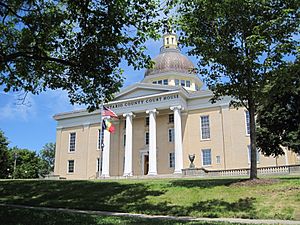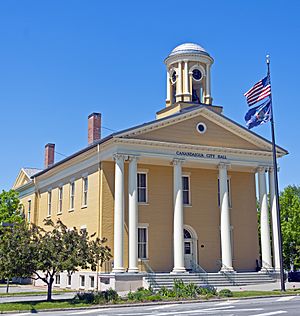Canandaigua, New York facts for kids
Quick facts for kids
Canandaigua
Utaʼnaráhkhwa
|
|
|---|---|
| City of Canandaigua | |

View north along Main Street, 2014
|
|
| Etymology: Tganǫdæ:gwęh Tuscarora for "The Chosen Spot" |
|
| Country | United States |
| State | New York |
| County | Ontario |
| Incorporation as village | 1815 |
| Incorporation as city | 1913 |
| Government | |
| • Type | Council–Manager |
| Area | |
| • Total | 4.83 sq mi (12.50 km2) |
| • Land | 4.56 sq mi (11.81 km2) |
| • Water | 0.27 sq mi (0.69 km2) |
| Elevation | 750 ft (230 m) |
| Lowest elevation | 690 ft (210 m) |
| Population
(2020)
|
|
| • Total | 10,576 |
| • Density | 2,319.30/sq mi (895.41/km2) |
| Time zone | UTC−5 (Eastern (EST)) |
| • Summer (DST) | UTC−4 (Eastern Daylight Time) |
| ZIP Code |
14424
|
| Area code(s) | 585 |
| FIPS code | 36-069-12144 |
| FIPS code | 36-12144 |
| GNIS feature ID | 0945739 |
| Wikimedia Commons | Canandaigua (city), New York |
| Website | City of Canandaigua |
Canandaigua is a city in Ontario County, New York, United States. About 10,576 people lived there in 2020. It is the main government center for Ontario County.
The name Canandaigua comes from the Seneca language. It means "place selected for a settlement" or "at the chosen town." This name was used for a historic village here long before Europeans arrived.
The city is located at the northern end of Canandaigua Lake. This lake is one of the famous Finger Lakes in New York. Canandaigua is about 24 miles southeast of Rochester. It is part of the larger Rochester area.
Contents
History of Canandaigua
Early Days and Native Americans
Canandaigua was first home to the Seneca people, a Native American group. Their village, called Kanandaigua, was located near Canandaigua Lake. French explorers visited this area in 1669. They saw a "burning spring" where natural gas escaped from the ground, making the water look like it was on fire.
During the American Revolutionary War, in 1779, the Seneca village was destroyed by American forces. This happened as a response to attacks by other Native American groups allied with the British. Many Seneca people had to leave their homes.
After the war, new settlers came from other parts of New York and New England. They founded Canandaigua Academy, the city's public high school, in 1791. In 1794, the Treaty of Canandaigua was signed here. This treaty was between the United States and the Iroquois (Six Nations).
Becoming a City
Canandaigua started as a village in 1815. It officially became a city in 1913. In the 1800s, it became an important place for railroads and steamboats on the lake.
A man named Jesse Hawley was held in the Canandaigua debtors' prison around 1807. While there, he wrote important ideas about building a canal. This canal would connect the Hudson River to Lake Erie, which later became the Erie Canal.
Important Events and People
Canandaigua has been a place where important events happened. In 1873, the Ontario County Courthouse in Canandaigua was the site of a famous trial. Susan B. Anthony, a leader for women's right to vote, was tried here for voting when only men were allowed. She was found guilty but refused to pay the fine.
Many notable people have connections to Canandaigua:
- Stephen A. Douglas, who later became a US Senator and ran for president against Abraham Lincoln, studied here.
- John Willys, who became a successful car maker, started a bicycle shop in Canandaigua.
- Theodore Roosevelt, a future US President, gave a speech here in 1900.
- In 1945, Marvin Sands started the Canandaigua Wine Company. This company grew into Constellation Brands, one of the world's largest wine and spirits companies.
- More recently, in 2006, President George W. Bush visited Canandaigua to talk about healthcare for seniors.
- Famous actress and comedian Kristen Wiig, known from Saturday Night Live, was born in Canandaigua.
- Ryan Lochte, an Olympic swimmer, also has ties to the area.
Today, Canandaigua is a busy center for business, healthcare, and education.
Geography and Climate
Location and Size
Canandaigua is about 4.8 square miles in size. Most of it is land, but a small part is covered by water from the lake. The city is at the northern end of Canandaigua Lake. This area is part of the Finger Lakes region, which is known for producing a lot of wine in New York State.
Major roads like U.S. Route 20 and New York Routes 5 and 21 pass through the city.
Weather in Canandaigua
Canandaigua has a humid continental climate. This means it has warm, humid summers and cold winters.
| Climate data for Canandaigua (1991–2020 normals, extremes 1944–present) | |||||||||||||
|---|---|---|---|---|---|---|---|---|---|---|---|---|---|
| Month | Jan | Feb | Mar | Apr | May | Jun | Jul | Aug | Sep | Oct | Nov | Dec | Year |
| Record high °F (°C) | 74 (23) |
74 (23) |
85 (29) |
89 (32) |
93 (34) |
96 (36) |
100 (38) |
101 (38) |
98 (37) |
89 (32) |
84 (29) |
72 (22) |
101 (38) |
| Mean daily maximum °F (°C) | 33.0 (0.6) |
34.6 (1.4) |
42.2 (5.7) |
55.2 (12.9) |
68.2 (20.1) |
76.9 (24.9) |
81.4 (27.4) |
80.2 (26.8) |
73.5 (23.1) |
60.8 (16.0) |
48.7 (9.3) |
38.1 (3.4) |
57.7 (14.3) |
| Daily mean °F (°C) | 25.4 (−3.7) |
26.5 (−3.1) |
33.5 (0.8) |
45.3 (7.4) |
57.5 (14.2) |
66.9 (19.4) |
71.7 (22.1) |
70.4 (21.3) |
63.6 (17.6) |
51.9 (11.1) |
41.1 (5.1) |
31.4 (−0.3) |
48.8 (9.3) |
| Mean daily minimum °F (°C) | 17.8 (−7.9) |
18.4 (−7.6) |
24.9 (−3.9) |
35.3 (1.8) |
46.8 (8.2) |
56.9 (13.8) |
62.0 (16.7) |
60.6 (15.9) |
53.8 (12.1) |
43.0 (6.1) |
33.4 (0.8) |
24.6 (−4.1) |
39.8 (4.3) |
| Record low °F (°C) | −17 (−27) |
−17 (−27) |
−10 (−23) |
10 (−12) |
25 (−4) |
34 (1) |
41 (5) |
40 (4) |
31 (−1) |
22 (−6) |
5 (−15) |
−12 (−24) |
−17 (−27) |
| Average precipitation inches (mm) | 1.92 (49) |
1.77 (45) |
2.65 (67) |
3.21 (82) |
3.13 (80) |
3.58 (91) |
4.06 (103) |
3.31 (84) |
3.12 (79) |
3.46 (88) |
2.59 (66) |
2.39 (61) |
35.19 (894) |
| Average precipitation days (≥ 0.01 in) | 16.4 | 13.7 | 14.2 | 14.4 | 12.6 | 12.4 | 11.9 | 11.4 | 11.5 | 15.2 | 13.6 | 15.3 | 162.6 |
| Source: NOAA | |||||||||||||
Population of Canandaigua
| Historical population | |||
|---|---|---|---|
| Census | Pop. | %± | |
| 1810 | 450 | — | |
| 1830 | 1,830 | — | |
| 1840 | 2,790 | 52.5% | |
| 1850 | 3,200 | 14.7% | |
| 1860 | 4,822 | 50.7% | |
| 1870 | 4,862 | 0.8% | |
| 1880 | 5,726 | 17.8% | |
| 1890 | 5,868 | 2.5% | |
| 1900 | 6,151 | 4.8% | |
| 1910 | 7,217 | 17.3% | |
| 1920 | 7,299 | 1.1% | |
| 1930 | 7,541 | 3.3% | |
| 1940 | 8,321 | 10.3% | |
| 1950 | 8,332 | 0.1% | |
| 1960 | 9,370 | 12.5% | |
| 1970 | 10,488 | 11.9% | |
| 1980 | 10,419 | −0.7% | |
| 1990 | 10,725 | 2.9% | |
| 2000 | 11,264 | 5.0% | |
| 2010 | 10,545 | −6.4% | |
| 2020 | 10,576 | 0.3% | |
| U.S. Decennial Census | |||
In 2010, there were 10,545 people living in Canandaigua. There were 4,789 households, and 2,470 families.
In 2000, the city had 11,264 people. About 23.3% of the population was under 18 years old. The average age was 39 years.
Education in Canandaigua
The Canandaigua City School District serves the city and nearby areas. It includes Canandaigua Academy, which is the local high school. The main campus of Finger Lakes Community College is also located just east of the city.
Fun Things to Do and See
Parks and Gardens
- Sonnenberg Gardens and Mansion State Historic Park: This is a beautiful Victorian mansion with 50 acres of gardens. It's open from May to mid-October, and you can visit for a fee.
- Kershaw Beach: Located at the north end of Canandaigua Lake, this beach is open to everyone for a small fee. It's a great place to swim and relax by the water.
- Canandaigua Lake State Marine Park: This park has boat ramps if you want to launch a boat onto Canandaigua Lake.
Unique Buildings and Attractions
- Octagon House: At 116 Gorham Street, you can see one of the few remaining Octagon Houses in New York. These unique eight-sided homes were popular for a short time.
- The Canandaigua Lady: This is a special double-decker paddle wheel boat. It looks like an old steamboat and offers public cruises on Canandaigua Lake from May to October.
Festivals and Events
Canandaigua hosts many fun festivals and events throughout the year:
- Finger Lakes Riesling Festival
- Waterfront Art Festival
- Canandaigua Art and Music Festival
- LakeMusic Festival
- Festival of Trees at the Granger Homestead and Carriage Museum
- Christkindl Market
- Finger Lakes Plein Air Festival
- Canandaigua Farmer's Market: You can find fresh local produce here from June to October.
Winter Fun
- Bristol Mountain: This is a winter resort in the Finger Lakes area. It has great views from the top and 38 slopes and trails for skiing and snowboarding. It's about 13 miles southwest of Canandaigua.
Historic Places to Visit
Many buildings and areas in Canandaigua are listed on the National Register of Historic Places. This means they are important historical sites. Some of these include:
- Adelaide Avenue School
- Benham House
- Brigham Hall
- Building at 426 South Main Street
- Canandaigua Historic District
- Canandaigua Veterans Hospital Historic District
- Thaddeus Chapin House
- Cobblestone Manor
- Granger Cottage
- Francis Granger House
- Marshall House
- North Main Street Historic District
- Saltonstall Street School
- Sonnenberg Gardens
- US Post Office - Canandaigua
- Woodlawn Cemetery
See also
In Spanish: Canandaigua para niños




